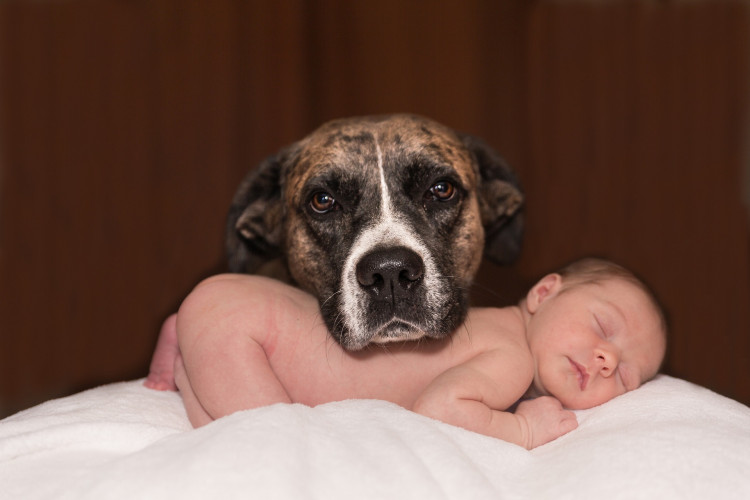Many young couples adopt a dog long before they think about having kids. The dog sees itself as a part of the family and is often just as excited as the parents when a new baby is announced.
In fact, when the little one finally makes it home, many parents immediately notice that the dog is overly attached to the infant.
If you’ve ever sat back and realized “my dog is obsessed with my newborn baby,” you might be wondering whether this attachment is safe.
Luckily, raising babies around dogs is normal, and that obsession might be more charming than you realize.
Understanding Dogs and Their Obsession with Babies
When you first bring a newborn home, it’s never surprising to find the dog nosing through the baby carrier as they eagerly try to meet the new family member.
Dogs love to be involved in family activities, and there’s nothing more exciting than meeting a new arrival to this world.
Although your dog’s baby obsession is perfectly natural, there are a few different tones it can take that may or may not be concerning.
Pay careful attention to the way your dog interacts with your child, and decide for yourself whether the behavior is safe.
Protective Tendencies
One of the first things that you’re likely to notice is that once your dog meets the baby, they aren’t going to want to leave it alone.
Many dogs follow newborns around the house, curl up under their crib, and complain when anyone other than the parents tries to disturb the sleeping child.
Most of the behaviors are rooted in protective tendencies towards the new member of the pack.
Dogs know quite well that newborn creatures of any species have a hard time making it past their first year.
Your dog wants your baby to survive, and that means they’ll try to protect them – just like a mother dog would try to protect her pups.
Canine protective tendencies aren’t dangerous, and they can even bring a sense of security to new parents.
Let your dog have an emotional presence in your newborn’s life, and you’ll be surprised at how little harm comes to your child.
Playful Tendencies
Many dogs, especially young ones, are thrilled when a new baby arrives because they believe they’ve finally found the playmate they’re looking for.
But although puppies are ready to run and tumble when they’re only a few months old, it can take years for a human baby to be prepared for these kinds of activities.
If your dog’s obsession with your baby seems too energetic or excited, you may want to keep a little distance between the two.
There’s something adorable about seeing your dog drop a chew toy in the baby’s crib, but there’s nothing cute about nipping, pushing, or other aggressive behavior.
The dog might think it’s playtime, but babies are far too small to keep up.
As a parent, it’s your job to moderate these situations and decide whether your dog’s behavior is appropriate.
To keep bad experiences to a minimum, you can avoid letting your dog and child alone together until the baby is much older.
Another way to help this situation is to make sure that your pup is getting plenty of playtime away from the baby.
Have the other parent take the dog out for walks and to play a little fetch; when your furry friend gets home, they’ll be too tired to bother the little one.
Possessive Tendencies
Some dogs are incredibly possessive and defensive towards their human family members.
If your pup has a strong guarding or herding instinct, they may develop a strong attachment to your newborn that isn’t necessarily healthy or safe.
Possessive behavior from a dog towards a baby might look like barking at the parents, standing between the crib and other family members, or attempting to own some of the baby’s items, like blankets or toys.
The tone on these behaviors is distinctly neither protective nor playful; if it feels like your dog is upset, there’s probably a reason.
Sometimes, these possessive behaviors occur because the dog isn’t getting nearly enough attention.
Make sure your pup is eating at the right times, going for walks, and getting the amount of playtime that they’re used to.
You will also need to firmly establish that the dog isn’t necessarily a part of the baby’s life. Try keeping them out of the nursery, and only let them see the baby under direct supervision.
Remember not to scold the dog heavily or take other steps that might create negative feelings about the baby.
You want your canine to forget about the little human, adjust to the new routine, and redevelop a healthier relationship later on.

Introducing a Baby into Your Dog’s Life
If you want your dog and your baby to like each other, you’ll need to carefully manage their introduction.
Help your dog get used to the idea that a baby will be entering their life; then, watch all moments carefully to make sure everyone stays safe.
Preparing the Environment
In the weeks leading up to your baby’s arrival, make sure that your home is both child and dog safe.
Remove hazards, create a smooth layout, and think about how your two dependent creatures will interact.
Get a baby gate for the nursery room so you can keep the dog out if needed.
Make sure the crib is too tall for your pup to jump into, and identify several safe spaces throughout the house where you can set the baby down without risking the dog getting in their face.
Establishing Good Ground Rules
With a new baby in the house, your dog will need to learn that they’re no longer the center of attention.
Ideally, you can establish this precedent by making the pregnant mother the center of attention instead. This will help you create habits that work after the baby is born.
Help the dog learn to be quiet in the evenings, to only ask for scheduled walks, and to quit barking at a moment’s notice.
You may also need to teach your pup that they’re no longer allowed in certain rooms of the house for the baby’s safety.
Monitoring the Introduction
When you first bring the baby into your home, resist the temptation to introduce them to the dog immediately.
Tensions will always be high during these first few moments, and you want to have more control over the introduction.
After the family has settled down and everyone has returned to any sense of normalcy, call the dog over to where you’re holding your child.
Then, depending on the size of your dog, find a way to let your pup have a good look at the new arrival.
It’s perfectly normal for your dog to sniff and lick the baby during this first interaction. Don’t let their faces get too close, but trust your pup; adding tension to this situation is never a good idea.
Maintaining Positive Experiences
Bad interactions between dogs and babies are usually difficult to get over.
Keep tensions low and prevent bad experiences from happening by carefully supervising every single time your dog is around your child.
Both dogs and babies tend to get tired easily, so keep moments to a minimum until your child is older. Your dog will probably be satisfied with sniffing the baby once or twice.
However, you should fully expect them to sleep under the crib and maintain a healthy but protective distance.
As your baby turns into a toddler, resist the temptation to let the dog babysit. Dogs react poorly when their ears are pulled, but this is exactly what your baby is going to do.
If your dog wants to participate, let them follow you around – but never leave your dog and your baby alone.
Keeping your baby safe around dogs is all about minimizing interactions. Dogs are animals, and as much as they love the family, they can’t be expected to care for a human child.
If you keep the two slightly separated until the baby is older, your dog and kid will be able to play together like they always wanted.

